DJI RS4 Mini review: smart-tracking turns this gimbal into an automatic camera arm
This gimbal adds intelligent subject-tracking to any camera
🏆 Review score: 4.5 out of 5
🏅 Editor’s Choice Award
Pros
✅ 🤖 Intelligent ActiveTrack follows subjects smoothly and accurately
✅ 🦾 Gimbal arm steadies all footage as you move around
✅ 🏋🏻♀️ Smaller gimbal size and weight are easier to carry around during shoots
✅ 🔄 Switching from landscape to vertical shooting takes seconds
✅ 📸 Supports full-frame cameras despite being so small
✅ 🔋 13-hour battery for all-day shooting
Cons
❌ 💸 Intelligent tracking requires a $90 combo upgrade or $69 separate purchase
❌ 🎒 Camera gimbals of any size are still too awkwardly shaped to pack
❌ 🔌 Integrated-battery can’t be replaced and is USB-C chargeable only
❌ 🚫 No hot- or cold-shoes for mounting accessories
❌ 📲 Mandatory smartphone pairing for first-time activation
Shortcut Review
The DJI RS4 Mini is the best camera gimbal for creators, whether you’re a YouTuber or an Instagram/TikTok star. The new intelligent tracking on the DS4 Mini is game-changing and does all the subject-tracking gimbal movements for you. This gimbal will give you steady footage with smooth motion even if you move around erratically.
Balancing your camera to get shooting with this gimbal has never been easier thanks to newly integrated autolocking mechanisms. Plus, the gimbal’s new design makes swapping to vertical shooting a breeze without needing to rebalance anything. It’s a little smaller than DJI’s full-sized camera gimbals, the RS4 and RS4 Pro, but it still supports larger full-frame cameras like the Canon R5 Mark II and Panasonic Lumix S5 II.
The DJI RS4 Mini pretty much has everything you need to create ultra-steady videos on the move for $369 to start, or $459 if you want the automatic tracking capabilities. You won’t need a more professional or larger gimbal unless you have a bigger camera setup or need to mount accessories like microphones and follow focus systems.
Full Review
🤖 Intelligent automatic tracking. The DJI RS4 Mini’s headlining feature is intelligent tracking that turns this gimbal into an automated camera arm that follows you or any subject of your choosing. The new feature requires the DJI RS Intelligent Tracking Module that clips onto the top of the gimbal arm. To start tracking, all you need to do is face the module, then show your palm toward the module’s small lens or press the gimbal’s trigger once, wait for the light on the module to turn green, and DJI’s Intelligent Tracking Module does the rest.
🎯 Locked on target. With Intelligent ActiveTrack turned on, the gimbal follows my movement while keeping me in the center of the frame. I can move up, down, left, right and even move in a 360-degree motion around the DJI RS4 Mini and it keeps me in frame. It’s also surprisingly smart at keeping one subject tracked. The Shortcut editor-in-chief Matt Swider and I tried to confuse the gimbal by running in opposite directions and jumping in front of each other. However, the DJI RS4 Mini stayed locked onto me, remembering that I initiated the tracking feature.
💃 Smooth motion. The automatic tracking is impressive, but I was even more pleased with how smooth the motion of the gimbal arm was. It doesn’t go overboard with instantaneous 1:1 tracking, as I’ve experienced with smartphone gimbals like the DJI Osmo Mobile 7P and insta360 Flow Pro 2. Even at its fastest setting with responsive tracking (smooth being the only other option), the camera gimbal made pans and tilts look organic as if I was just moving the camera around by myself.


👾 Stacking on AI. Since I first heard about the DJI RS4 Mini’s intelligent tracking capability, I wanted to see if it could work in tandem with the Sony ZV-E1 AI-powered autoframing feature. Together, the two tracking solutions work surprisingly well. The Sony ZV-E1’s auto framing works well on its own, but it can introduce some distortion as you move toward the edges of the lens, especially for ultrawide angle lenses. The DJI RS4 Mini AI tracking keeps you centered in the frame, squashing that issue. At the same time, the Sony ZV-E1’s auto framing helps ensure you’re always in frame even if you move faster than the gimbal arm can rotate.
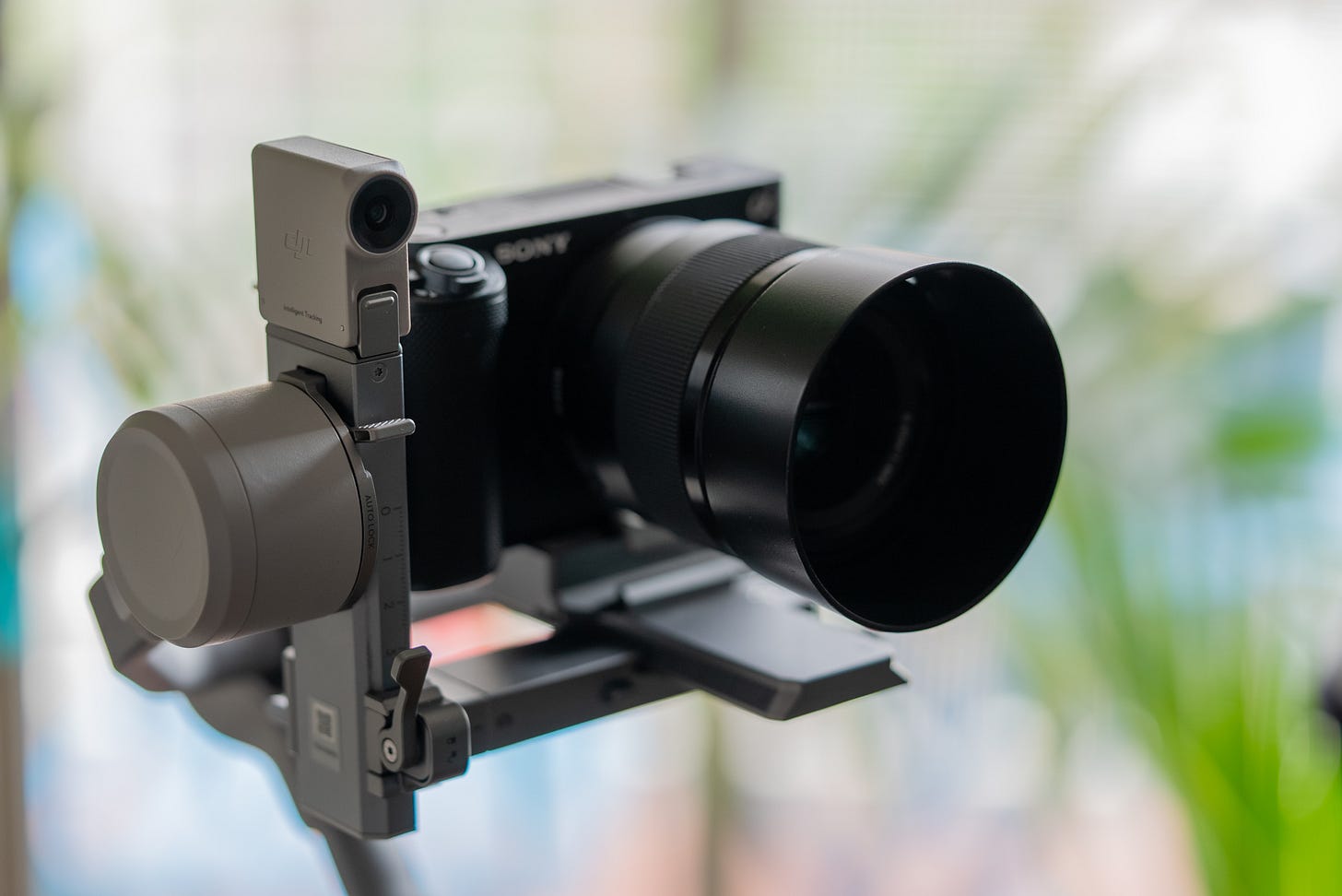
🦾 Machine stabilized. This camera gimbal makes all camera movement look stable. If you’ve ever recorded unusable, shaky hand-shot footage with a camera before, the DJI RS4 Mini fixes that problem. It’ll even slow down your pans and tilts for a smoother motion if you’re wildly swinging the camera around. The DJI RS4 Mini also helps reduce the bobbing motion from walking. You still need to consciously keep the camera stable, but you don’t have to ninja walk to make your footage look stable.
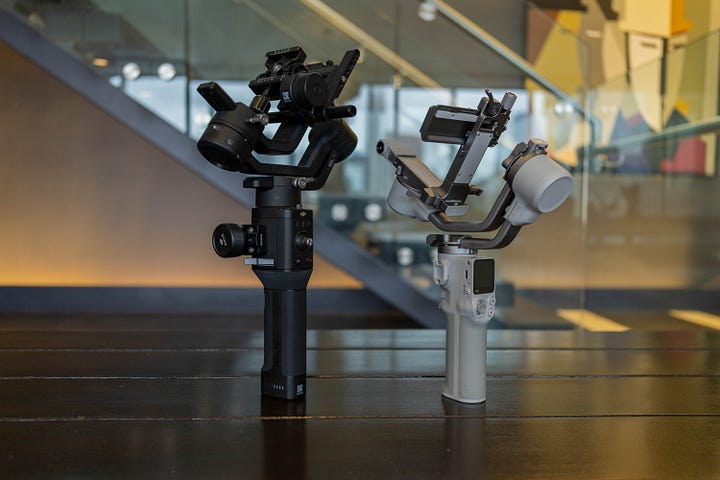
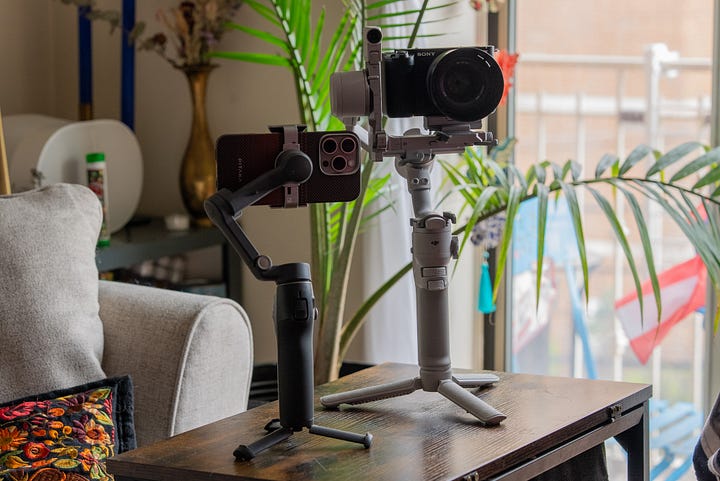
🤏 It’s so small. When I pulled the DJI RS4 Mini out of my bag, Matt was astounded and asked if it was actually a phone stabilizer. That just goes to show just how small DJI’s gimbals have become. Standing it up next to the OG Ronin-SC, you can see how much shorter the handle and smaller the gears are. Compared to the previous DJI RS3 Mini, the RS4 Mini is actually a little taller and heavier by 0.2 pounds due to all the improvements.
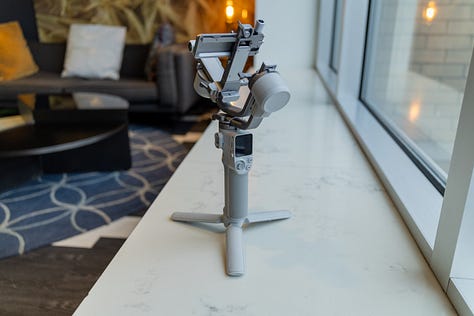
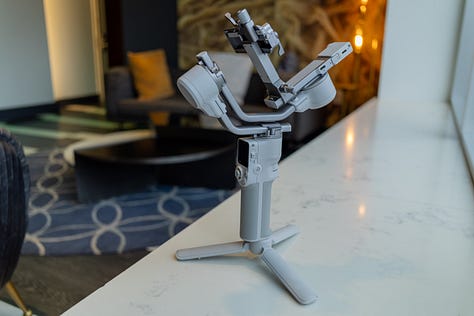
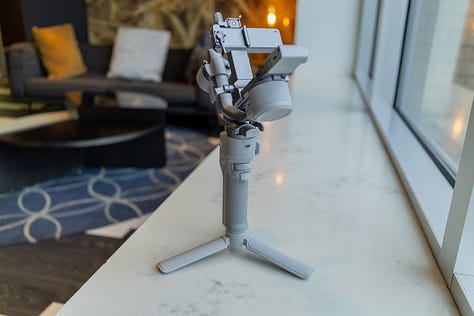
🎒 Carrying issues. The DJI RS4 Mini is still much larger than the DJI Osmo Mobile 7P or any smartphone gimbal, which makes it harder to pack. It slips into a regular backpack with ease, but it takes up almost all the space. It’s simply too big to pack inside a camera bag with camera compartments like the Peak Design Backpack. I mostly had to strap it into the side compartment or just carry it in my hand while on the go.
📸 Big camera support. This camera gimbal might be small, but the DJI RS4 Mini can support a surprising number of cameras. I tested the gimbal with the compact Sony ZV-E1 and modestly-sized Sony FX3, but it can support big full-frame cameras like the Canon R5 II and Panasonic Lumix S5 II. You can even have large 24-70mm f2.8 lenses attached to all these cameras, and the DJI RS4 Mini will be able to handle it as long as the total weight of the payload is under 4.4 pounds. You’ll need the bigger RS4 or RS4 Pro for any larger or heavier camera setups.
🔒 Automated locks. The DJI RS4 Mini has inherited the automatic locks from the DJI RS4 and RS4 Pro, and they’re fantastic. When you turn off the gimbal, it resets all the axes and locks them with an audible click for easier carrying. You can also manually engage the locks, which utilize a small mechanical switch, to make balancing the gimbal a cinch.
🛠️ Easy setup. Speaking of setup, it’s never been easier-to-balance camera gimbal than the DJI RS4 Mini. It only requires three steps to find the right balance for the tilt, pan, and roll of the camera, and the ability to lock off other axes simplifies dialing each one in. There’s also a new Teflon coating on the balancing parts of the gimbal, so they all slide uniformly as you’re trying to minutely adjust the balance. There’s only one first set-up headache with this gimbal that requires you to pair it to the DJI Ronin smartphone app, which requires you to input a pointless default password of ‘12345678.’
🔄 Horizontal-vertical quickswap. Wanna switch to vertical shooting? It only takes a second with the DJI RS4 Mini. This gimbal’s camera plate comes attached to a quick release, so you can simply take it off, turn it, and reattach it to shoot vertically. You don’t have to rebalance it either, which also expedites the whole process.
🤳 Smartphone shooting. The DJI RS4 Mini also works with smartphones if you get the phone holder separately or the one included with the top-tier Creator Combo. It looks ridiculous to have a super thin iPhone 16 Pro on top of a much bigger gimbal, but if you want to capture some tracking and/or stabilized footage with your phone, the DJI RS4 Mini will do the trick. I’d recommend the DJI Osmo Mobile 7P and insta360 Flow Pro 2 if you need a gimbal to shoot mostly smartphone video since the AI tracking on both those gimbals is more sophisticated and works more deeply with certain apps.
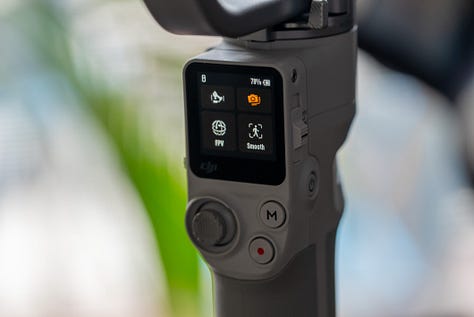
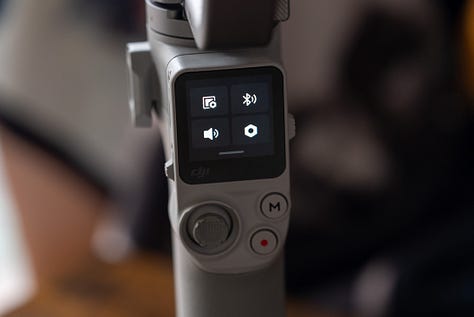
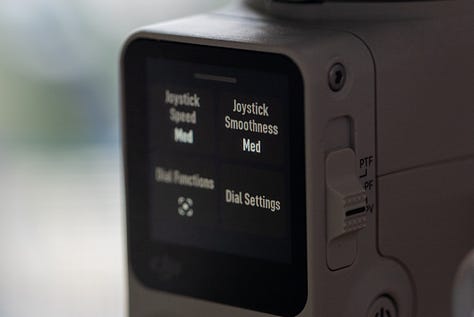
🔋13 hour battery. You can get up to 13 hours of usage out of the DJI RS4 Mini. However, it uses a battery integrated into the handle, unlike the swappable batteries on the fuller-sized DJI RS4 and RS4 Pro. So you’ll need to plug a USB-C cable or battery into the gimbal to recharge it and wait two hours for it to replenish. 13 hours of battery life is still plenty for a full day of shooting, so you’re unlikely to run dry in the middle of recording. But since the battery isn’t easily replaceable, you should check the power level and plan accordingly whenever you need this camera gimbal.
💵 Money matters. The DJI RS4 Mini starts at $369, however, if you want to use its intelligent tracking, you’ll have to buy the Combo version for $459. Curiously, it’s actually cheaper to buy the Intelligent Tracking Module on its own for $69 if you don’t care for the Combo version’s additional briefcase handle accessory. The Creator Combo version I’m testing with all the extra parts, including an additional phone holder, goes for $478.
Should you buy the DJI RS4 Mini?
Yes, if…
✅ 🦾 You want a futuristic camera arm that follows your movements
✅ 🫨 You need stabilized video footage
✅ 🔄 You’re constantly switching between horizontal and vertical shooting
✅ 😌 You’ve been waiting for an easier-to-use gimbal
No, if…
❌ 🤳 You mostly record movies on a smartphone (get the insta360 Flow Pro 2 instead)
❌ 🎥 You have a heavy camera for video (get the DJI RS4 instead)
❌ 📹 You don’t need intelligent tracking (get the DJI RS3 Mini instead)
Kevin Lee is The Shortcut’s Creative Director. Follow him on Twitter @baggingspam.













Good review. However, just want to mention that the tracking is not AI. It sounds confusing officially being called “intelligent” tracking but it does not have any AI features built into the module.